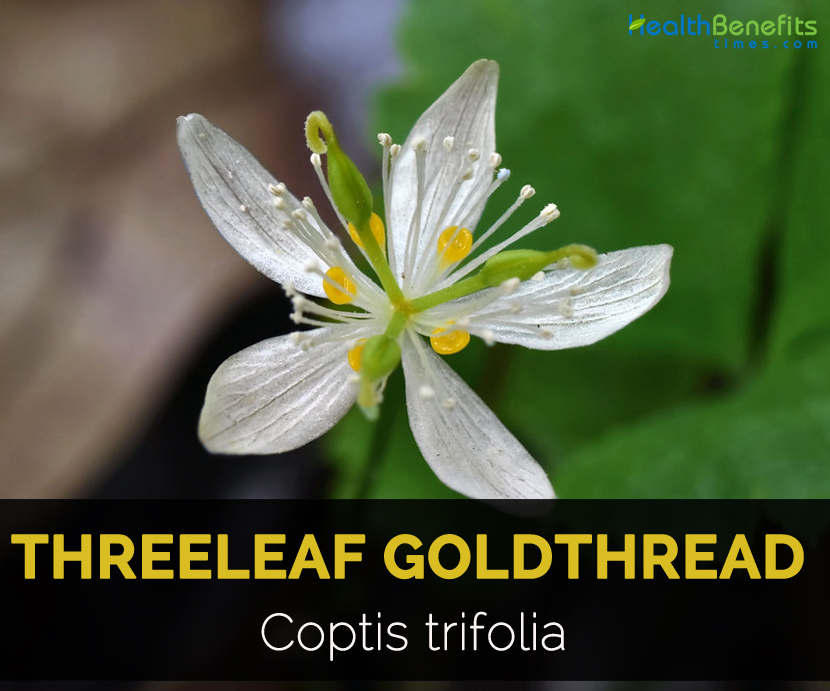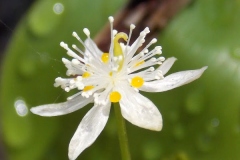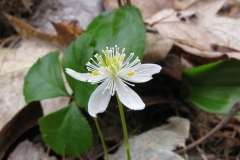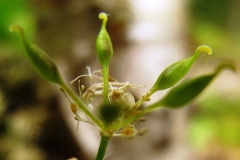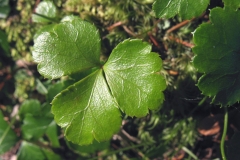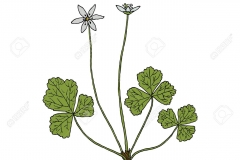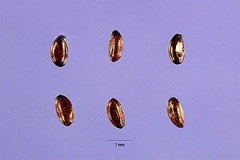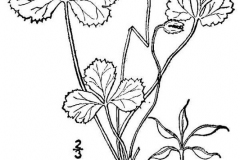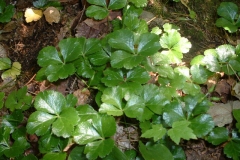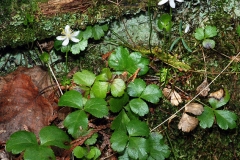The common name refers to the yellow, thread-like underground roots. Goldthread, Queen of the Meadow, Joe-Pye Weed, Kidney Root, Trumpet Weed, Purple Boneset, Yellowroot, Vegetable Gold, Mouth-Root, Coptis, Yaller Root, Dye Root and Golden-Seal are some of the popular common names of the plant. Another common name, Canker-root is derived from the fact that early settlers and Indians used this plant to treat mouth sores. The genus name Coptis comes from the Greek word meaning “to cut.” This is a reference to the divided leaves. The word “trifolio” means “having three leaves,” a reference to the number of leaflets. Goldthread is listed in some guide books as Coptis groenlandica – an earlier scientific name.
Threeleaf Goldthread Facts
| Threeleaf goldthread Quick Facts | |
|---|---|
| Name: | Threeleaf goldthread |
| Scientific Name: | Coptis trifolia |
| Origin | Northeastern United States and much of Canada |
| Colors | Green to tan or light brown |
| Shapes | Array of four to seven pods, each about 1/3 inch long |
| Taste | Pure, bitter taste |
| Health benefits | Beneficial for sore throats, acne, boils, carbuncles, burns, infected cuts, swollen gums, tongue ulcers, vomiting, diarrhea and bacterial dysentery |
| Name | Threeleaf goldthread |
|---|---|
| Scientific Name | Coptis trifolia |
| Native | Northeastern United States and much of Canada. The plant is listed as endangered in Maryland and classified as sensitive in Washington. |
| Common Names | Goldthread, Queen of the Meadow, Joe-Pye Weed, Kidney Root, Trumpet Weed, Purple Boneset, Yellowroot, Vegetable Gold, Canker-Root, Mouth-Root, Coptis, Yaller Root, Dye Root and Golden-Seal |
| Name in Other Languages | Arabic: Kubts taryfulia (كوبتس تريفوليا) English: American goldthread, Canker-root, Goldthread, Threeleaf goldthread, Goldenroot, Savoyana, Three-leaved goldthread, Yellow snakeroot French: Savoyane, Coptide du Groenland, Coptide savoyane, Sabouillane, Sibouillane German: Dreiblättriger Goldfaden, Goldfaden Japanese: Mitsuba-ô-ren (ミツバオウレン) Pdc: Goldwatzel Russian: Koptis trokhlistnyy (коптис трёхлистный) Swedish: Polarkoptis |
| Plant Growth Habit | Small low-growing, evergreen, perennial |
| Growing Climates | Wet to mesic, coniferous and mixed forests, bogs, willow scrub, and tundra |
| Plant Size | 5–6 ft. tall |
| Stem | Slender and hairless |
| Leaf | Leaves are compound, divided into three scalloped leaflets |
| Flowering season | May |
| Flower | Solitary, small white flower on a long, slender, leafless stem. Each flower is ⅜ to ½ inch across and has four to seven petal-like sepals and many white stamens |
| Fruit Shape & Size | Array of four to seven pods, each about 1/3 inch long |
| Fruit Color | Green to tan or light brown |
| Taste | Pure, bitter taste |
| Plant Parts Used | Dried rhizome, with roots, stems, and leaves |
| Culinary Uses |
|
Plant Description
Threeleaf goldthread is a small low-growing, perennial evergreen plant that normally grows about 5–6 ft. tall. The plant is found growing in wet to mesic, coniferous and mixed forests, bogs, willow scrub, and tundra. The plant has slender and hairless stem. The plant has attractive, glossy evergreen leaves that are 1-2 inches wide and appear at the end of a stem which is usually shorter than the flower stem. The leaves are compound, divided into three scalloped leaflets. The leaflets are fan-shaped, with small teeth around the tip end. Goldthread’s leaves uncoil every spring like a fern, as they replace the old evergreen leaves of the previous year.
Flower
Threeleaf Goldthread bears a solitary, small white flower on a long, slender, leafless stem. Each flower is ⅜ to ½ inch across and has four to seven petal-like sepals and many white stamens. The bright green styles are curled at the tip. The golden yellow club-shaped petals are shorter than the stamens and have a cup-shaped tip that holds nectar. Most plants have only one flowering stem. Flowering normally takes place from May.
Fruit
Fertile flowers are followed by an array of four to seven pods, each about 1/3 inches long. The capsule-like fruit changes from green to tan or light brown and splits open to expose the seeds.
Uses
The strong decoction of the root is esteemed almost an infallible remedy for gravel and accumulations of the associated bladder, kidney and the urinary system. To mention a few: dropsy, neuralgia, lumbago, gout, rheumatism and joint stiffness caused by uric acid deposits. It has also been recognized as being an agent for sterility, threatened abortion, as well as incontinence of urine. Queen of the meadow is also used in nerve fibres, which once destroyed can never be replaced.
Homoeopathic Clinical
Tincture of the root—Albuminuria, Calculi, Cystitis, Diabetes, Dropsy, Enuresis, Gravel, Headache, Home-sickness, Hysteria, Impotence, Indigestion, Intermittent fever, Renal colic, Rheumatism, Sciatica, Strangury, Throat (sore), Urine (retention of), Vomiting.
Traditional uses and benefits of Threeleaf goldthread
- Goldenthread is a very bitter tasting herb that was formerly highly valued and widely used in North America by the native Indians and white settlers alike, though it is little used in modern herbalism.
- It was used mainly to treat any soreness in the mouth.
- Dried roots, stems and leaves are anti phlogistic, highly astringent, sedative, stomachic, tonic.
- Plant is valued as a local application in the treatment of thrush in children.
- It is also used in the treatment of ulcerated mouths and as a gargle for sore throats or mouths.
- It is said to be useful in the treatment of dyspepsia and helpful in combating the drink habit.
- The plant contains the alkaloid ‘berberine’, which is a mild sedative, anti-inflammatory and antibacterial.
- Rhizome and roots are said to have antibacterial properties.
- They have also been used to heal sores of eyes, for thrush, as a tonic, and as a cure for alcoholism.
- The plant was also used as a gargle for sore throats and made into a tea for use as eyewash.
- It can protect against some types of harmful organisms and soothe irritated tissue.
- It encourages normal lipid profiles and is even known to boost the immune system.
- Berberine promotes heart health, bone and joint health, brain health, digestive health, liver health, and is beneficial for the respiratory system.
- It is used for inflammations of mucous membranes in the mouth and around eyes.
- It is used for treating alcoholism.
- It is used for treating gastrointestinal problems such as vomiting, diarrhea and bacterial dysentery.
- It is used for treating mouth sores such as canker sores, swollen gums and tongue ulcers.
- On the skin it is used topically to treat acne, boils, carbuncles, burns, and infected cuts.
Other Facts
- Yellow dye is obtained from the leaves and stems.
- It can be grown as a ground cover plant in the peat garden.
- The roots of this species have also been used to flavor beer.
- Some Native American groups also used the roots as a yellow dye.
Precautions
- It may cause headache, fatigue, high blood pressure.
- Berberine can also lower blood glucose and should be used with caution in people taking diabetes medications.
- Coptis trifolia can interact with the immunosuppressive drug cyclosporine used to prevent organ rejection and treat certain autoimmune diseases.
- Coptis trifolia may speed the breakdown of cyclosporine and reduce the drug’s efficacy.
- Coptis trifolia should be avoided if you are being treated with cyclosporine.
References:
https://www.itis.gov/servlet/SingleRpt/SingleRpt?search_topic=TSN&search_value=18767#null
https://pfaf.org/user/Plant.aspx?LatinName=Coptis+trifolia
https://en.wikipedia.org/wiki/Coptis_trifolia
https://www.dnr.wa.gov/publications/amp_nh_cotr2.pdf?ko7ffe
https://practicalplants.org/wiki/Coptis_trifolia


